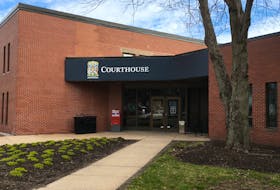It’s only 4.8 kilometres, but plans for the Grand Concourse trail that winds from King’s Bridge Road to Columbus Drive have sparked countless opinions.
Called the Kelly’s Brook Shared-Use Path, it’s the first project in the Bike St. John’s Master Plan — a city initiative to create an inter-connected, active transportation route.
In June last year, city council officially adopted the plan, and in October this year it received provincial and federal funding to cover more than 80 per cent of the cost to complete the Kelly’s Brook section.

Coun. Dave Lane, council representative for the Bike St. John’s Advisory Committee, says the public will be consulted in the coming weeks before any work begins.
“I have a concern that people think that what is in the bike plan is set in stone, and this is absolutely what council is going to do and there’s no changing it — and there’s nothing further from the truth,” says Lane.
“We’re going to take a look at this, hear from everybody, and then design something on one trail that hopefully is something that everyone can appreciate and value.”
Whether or not one design will appease everyone’s concerns remains to be seen.
Some see the plan as wonderful news — a way to make the city more accessible, encourage more people to lead an active lifestyle, and tackle climate change.
Others are worried that putting fast-moving bicycles on a trail with pedestrians, children, seniors and people with disabilities will pose safety risks, and that widening the paths to three metres will be detrimental to the environment.

Environmental considerations
Salmonid Association of Eastern Newfoundland (SAEN) vice-president Kevin Power says the organization “looked with alarm” at the plans for a section of the trail near Rennie's River.
The organization has worked tirelessly over the years to clean up the river and improve the habitat for fish.
Power says the group is worried plans to widen some narrow sections of the trail will mean removing riverside vegetation important for the health of the fish.
SAEN wants to see an environmental impact assessment completed.
“And understand what the potential impacts to, in our case, salmonid species are, and whether those impacts can be mitigated safely. And if they can’t be mitigated, we’d certainly like to see alterations to that plan such that those harmful effects to salmonid species do not occur.”
The city’s request for proposals for work on the Kelly’s Brook project says the contractor, Stantec Consulting, has to apply for all required environmental permits, including a permit from the province for an alteration to a body of water, and a permit for projects near water from Fisheries and Oceans Canada.
Joel Finnis is a climatologist at Memorial University. He lives in the area and walks to and from work most days using the trail.
He has experience in flood prediction, hazard modelling, river remediation and flood mitigation.
Finnis thinks the shared-use path is an excellent idea.
He says it encourages wider use of active transport, which is good news from a climate change mitigation perspective.
“I certainly think that doing it properly you wouldn’t have much in the way of a concern,” he says.
“If there are projected impacts, they really should be worked around. Some kind of mitigation should be built in to make sure that those impacts are reduced.”

Allows accessibility
Anne Malone also lives in the area and uses the trails frequently with her guide dog, Cheryl.
Malone is visually impaired, so she says the trails are a great way for her to get around the city without having to deal with traffic.
She calls the shared-use path a necessary step in progress.
“A lot of investment is rightfully made in outdoor recreational activity for residents of the city. However, people who have disabilities are also residents of the city, we also pay taxes, and we do not get equal access to the public spaces in the city,” she says.
“St. John’s is a beautiful jewel in Atlantic Canada. Let’s make it the most accessible jewel in Atlantic Canada.”
Malone says accessibility is a right, not a privilege.
“It’s not something you add on if there’s enough money in the budget, or if everybody’s OK with it, or if it doesn’t interfere with a certain aesthetic or other principle.
“And while sometimes we have to weigh different sides of an issue to make a decision for the greater good, rather than for a particular group, I also think that many of the people who are resisting this change may have other options of where to run, or where to cycle, or walk. People with disabilities don’t have that option. We have very few options right now.”
Malone and Meghan Hollett, another area resident, teamed up recently to paint rocks with messages about the importance of accessibility. They placed the rocks along the path.
“The rocks are a way to remind us: who do we not see on the trail?” says Hollett.
She says the trails were originally made without everybody in mind.
“I think it’s time for us to change that. And we have this opportunity.”

Safety concerns
Geoff Budden and Holly Foley are avid runners who regularly use the trails.
As they walk from King’s Bridge Road, following the trail along Rennie's River, they point to a number of areas where they question how it would be feasible to create a safe shared-use path with cyclists.
They stop near a steep hill.
“Even if the trail was widened slightly, I still think there’s a significant safety concern with having bikes on asphalt that can, on these grades, easily hit 50 to 60 kilometres per hour — there’s some big hills here,” says Foley.
Budden says there’s already issues with cyclists using the trails, even though there’s signs up saying they’re not permitted.
Foley wonders who would enforce any rules that would be in place for the shared-use path when rules about bikes on the current narrow trails aren’t enforced.
“I think we would be very naive to believe that common courtesy is always going to be at play here,” she says.
Educating the public about best practices when using a shared-use path is something Bicycle Newfoundland and Labrador (BNL) is working on.
The group has created videos to show cyclists some tips, such as signalling with a bell, not speeding, and being prepared to stop.
Director of marketing and communications Ryan Green says BNL supports the plan for a shared-use path.
“The research shows that for (cycling) infrastructure to be successful, it needs to be well-connected, and it needs to be separated from vehicle traffic. I think the bike master plan addresses that.”

But not all cyclists support the plan.
Melanie Benson is an accomplished triathlete, cyclist, and an endurance coach. She’s currently working overseas, but enjoys the trails when she’s in St. John’s.
She’s concerned about what a shared-use path will mean for the safety of all users.
She says in her experience, speed limits and courtesy don’t determine how a bike path is used; rather, the design will determine behaviour.
She says bikes will move fast down hills, and won’t be able to see people if there’s turns and vegetation in the way.
“If the design isn’t well thought out, then expect people to get hurt.”
She says at a minimum pedestrians and cyclists should be separated on their own distinct paths.

Malone, however, says she’s not worried about sharing the space with cyclists.
“I share spaces with bikes all the time because a lot of cyclists — because of some of the questionable driving practices — do from time to time ride on the sidewalk.”
She says she’s never been injured by a cyclist riding on the sidewalk.
“I don’t think that the safety issue is as large as the accessibility issue.”
Juanita Mercer reports on municipal matters in St. John’s.









